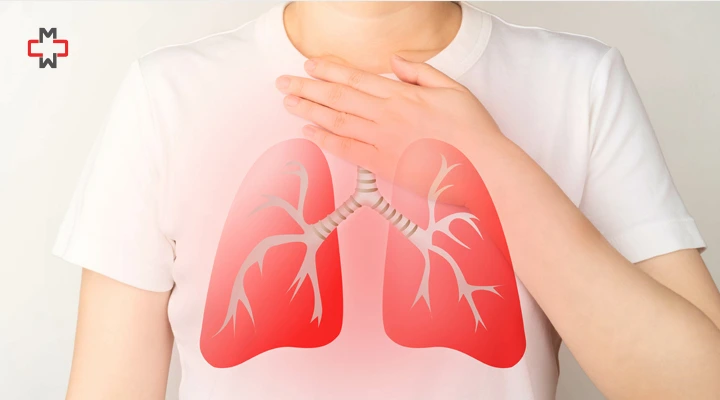There are certain medical conditions that demand our attention more than others, due to their potential to disrupt the delicate balance of our body’s vital functions. Pulmonary edema is one such example – a condition that is found deep into our respiratory systems, affecting the very essence of our breath.
Defined by the abnormal accumulation of fluid within the lung’s network, pulmonary edema can cast a shadow on our ability to exchange life-sustaining gases.
In this blog by Manhattan Medical Arts, let’s unravel the layers of this condition and understand what pulmonary edema is – from its definition and underlying causes to the telltale symptoms that it brings along.
We’ll also navigate its prevention as well as treatment options, equipping you all with the required knowledge to safeguard your respiratory well-being.
What is Pulmonary Edema?
Pulmonary edema is a medical condition characterized by the abnormal accumulation of fluid within the lung tissues and air sacs, which are responsible for the exchange of oxygen and carbon dioxide during the breathing process. This fluid buildup interferes with the lungs’ ability to effectively oxygenate the blood and remove carbon dioxide, leading to breathing difficulties and potentially severe respiratory distress.
Pulmonary edema is often associated with underlying medical conditions, such as heart failure, kidney dysfunction, or severe infections, and it requires prompt medical attention and treatment to alleviate symptoms and address the root cause.
What Causes Pulmonary Edema?
Pulmonary edema often occurs when the tiny blood vessels in the lungs, known as capillaries, become leaky and allow fluid to escape into the lung tissues and air sacs. This fluid accumulation interferes with the normal exchange of oxygen and carbon dioxide, leading to breathing difficulties.
Several factors can contribute to the development of pulmonary edema, such as:
- Heart Conditions:
One of the leading causes of pulmonary edema is congestive heart failure, where the heart’s pumping ability is compromised, causing fluid to back up into the lungs.
- Kidney Dysfunction:
Impaired kidney function can lead to an accumulation of fluid in the body, including the lungs.
- Infections:
Severe respiratory infections, such as pneumonia, can cause inflammation and fluid buildup in the lungs.
- High Blood Pressure:
Uncontrolled hypertension can strain the heart and contribute to pulmonary edema.
- Inhalation of Irritants:
Exposure to toxic fumes or chemicals can damage lung tissues and trigger fluid leakage.
Pulmonary Edema Symptoms
Recognizing the pulmonary edema symptoms is crucial in order to seek timely medical attention. The most commonly reported pulmonary edema symptoms include:
- Shortness of Breath:
Often the first and most prominent pulmonary edema symptom, patients may experience difficulty breathing even at rest.
- Coughing:
A persistent, frothy, pink-tinged cough may be present due to the presence of blood-tinged fluid in the lungs.
- Rapid Heart Rate:
An increased heart rate may occur as the heart attempts to compensate for decreased oxygen levels.
- Wheezing and Gurgling Sounds:
These sounds may be audible due to the presence of fluid in the airways.
- Cyanosis:
Bluish discoloration of the lips, fingers, and nails can result from inadequate oxygenation.
Prevention from Pulmonary Edema
While some risk factors for pulmonary edema, such as genetic predisposition, cannot be modified, there are steps that individuals can take to reduce their risk:
- Manage Underlying Conditions:
Effectively managing conditions like heart disease, hypertension, and diabetes can help prevent pulmonary edema.
- Lifestyle Modifications:
Adopting a healthy lifestyle through regular exercise, maintaining a balanced diet, and avoiding smoking can contribute to overall cardiovascular health.
- Medication Adherence:
Taking prescribed medications as directed by a healthcare provider is crucial for managing conditions that can lead to pulmonary edema.
Pulmonary Edema Treatments
Pulmonary Edema treatment focuses on addressing the underlying cause and alleviating the symptoms:
- Oxygen Therapy:
Supplemental oxygen can help improve oxygen levels in the blood and relieve breathing difficulties.
- Diuretics:
These medications help eliminate excess fluid from the body, reducing fluid buildup in the lungs.
- Medications:
Depending on the cause, medications such as vasodilators or inotropes may be prescribed to improve heart function and reduce strain on the heart.
- Lifestyle Changes:
Patients are often advised to make necessary lifestyle changes to manage underlying conditions and prevent recurrence.
- Medical Procedures:
In severe cases, medical procedures like mechanical ventilation or even surgery may be necessary.
Conclusion
Pulmonary edema is a serious medical condition that requires prompt diagnosis and intervention. Understanding its causes, recognizing its symptoms, and adopting preventive measures can significantly reduce the risk of developing this condition.
If you or a loved one experiences pulmonary edema symptoms, seeking immediate medical attention is crucial for a timely and effective management plan. Make sure to consult our expert healthcare professionals at Manhattan Medical Arts for accurate diagnosis and personalized treatment.
– Disclaimer –
This blog is for informational & educational purposes only, and does not intend to substitute any professional medical advice or consultation. For any health related concerns, please consult with your physician, or call 911.
-
About The Author
Dr. Syra Hanif M.D.Board Certified Primary Care Physician
Dr. Syra Hanif is a board-certified Primary Care Physician (PCP) dedicated to providing compassionate, patient-centered healthcare.
Read More







